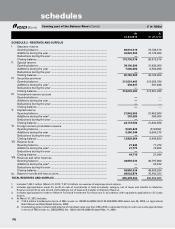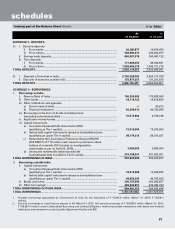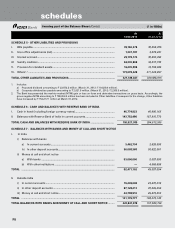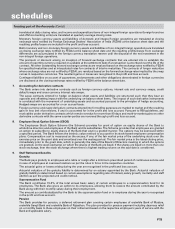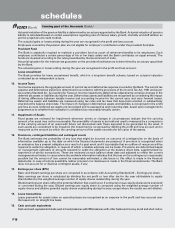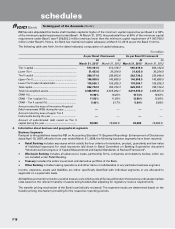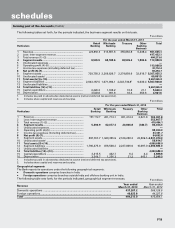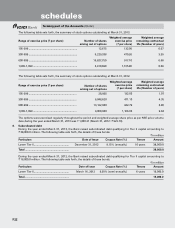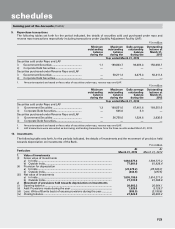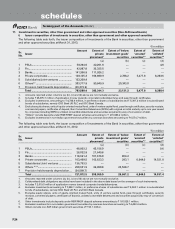ICICI Bank 2013 Annual Report Download - page 93
Download and view the complete annual report
Please find page 93 of the 2013 ICICI Bank annual report below. You can navigate through the pages in the report by either clicking on the pages listed below, or by using the keyword search tool below to find specific information within the annual report.
F15
translated at daily closing rates, and income and expenditure items of non-integral foreign operations (foreign branches
and offshore banking units) are translated at quarterly average closing rates.
Monetary foreign currency assets and liabilities of domestic and integral foreign operations are translated at closing
exchange rates notified by Foreign Exchange Dealers’ Association of India (FEDAI) at the balance sheet date and the
resulting profits/losses are included in the profit and loss account.
Both monetary and non-monetary foreign currency assets and liabilities of non-integral foreign operations are translated
at closing exchange rates notified by FEDAI at the balance sheet date and the resulting profits/losses from exchange
differences are accumulated in the foreign currency translation reserve until the disposal of the net investment in the
non-integral foreign operations.
The premium or discount arising on inception of forward exchange contracts that are entered into to establish the
amount of reporting currency required or available at the settlement date of a transaction is amortised over the life of the
contract. All other outstanding forward exchange contracts are revalued based on the exchange rates notified by FEDAI
for specified maturities and at interpolated rates for contracts of interim maturities. The contracts of longer maturities
where exchange rates are not notified by FEDAI, are revalued based on the forward exchange rates implied by the swap
curves in respective currencies. The resultant gains or losses are recognised in the profit and loss account.
Contingent liabilities on account of guarantees, endorsements and other obligations denominated in foreign currencies
are disclosed at the closing exchange rates notified by FEDAI at the balance sheet date.
7. Accounting for derivative contracts
The Bank enters into derivative contracts such as foreign currency options, interest rate and currency swaps, credit
default swaps and cross currency interest rate swaps.
The swap contracts entered to hedge on-balance sheet assets and liabilities are structured such that they bear an
opposite and offsetting impact with the underlying on-balance sheet items. The impact of such derivative instruments
is correlated with the movement of underlying assets and accounted pursuant to the principles of hedge accounting.
Hedged swaps are accounted for on an accrual basis.
Foreign currency and rupee derivative contracts entered into for trading purposes are marked to market and the resulting
gain or loss (net of provisions, if any) is accounted for in the profit and loss account. Pursuant to RBI guidelines, any
receivables under derivative contracts which remain overdue for more than 90 days and mark-to-market gains on other
derivative contracts with the same counter-parties are reversed through profit and loss account.
8. Employee Stock Option Scheme (ESOS)
The Employees Stock Option Scheme (the Scheme) provides for grant of option on equity shares of the Bank to
wholetime directors and employees of the Bank and its subsidiaries. The Scheme provides that employees are granted
an option to subscribe to equity shares of the Bank that vest in a graded manner. The options may be exercised within
a specified period. The Bank follows the intrinsic value method to account for its stock-based employee compensation
plans. Compensation cost is measured as the excess, if any, of the fair market price of the underlying stock over the
exercise price on the grant date and amortised over the vesting period. The fair market price is the latest closing price,
immediately prior to the grant date, which is generally the date of the Board of Directors meeting in which the options
are granted, on the stock exchange on which the shares of the Bank are listed. If the shares are listed on more than one
stock exchange, then the stock exchange where there is highest trading volume on the said date is considered.
9. Staff Retirement Benefits
Gratuity
The Bank pays gratuity to employees who retire or resign after a minimum prescribed period of continuous service and
in case of employees at overseas locations as per the rules in force in the respective countries.
The actuarial gains or losses arising during the year are recognised in the profit and loss account.
Actuarial valuation of the gratuity liability is determined by an actuary appointed by the Bank. Actuarial valuation of
gratuity liability is determined based on certain assumptions regarding rate of interest, salary growth, mortality and staff
attrition as per the projected unit credit method.
Superannuation Fund
The Bank contributes 15.0% of the total annual basic salary of certain employees to a superannuation fund for its
employees. The Bank also gives an option to its employees, allowing them to receive the amount contributed by the
Bank along with their monthly salary during their employment.
The amount so contributed/paid by the Bank to the superannuation fund or to employee during the year is recognised
in the profit and loss account.
Pension
The Bank provides for pension, a deferred retirement plan covering certain employees of erstwhile Bank of Madura,
erstwhile Sangli Bank and erstwhile Bank of Rajasthan. The plan provides for pension payment including dearness relief
on a monthly basis to these employees on their retirement based on the respective employee’s years of service with the
Bank and applicable salary.
forming part of the Accounts (Contd.)
schedules



